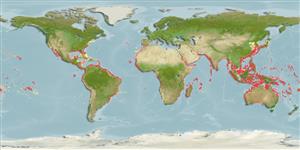Preferred temperature (संदर्भ
123201): 16.4 - 27.8, mean 24.8 °C (based on 400 cells).
Phylogenetic diversity index (संदर्भ
82804): PD
50 = 1.0000 [Uniqueness, from 0.5 = low to 2.0 = high].
Bayesian length-weight: a=0.02239 (0.01363 - 0.03678), b=2.84 (2.70 - 2.98), in cm total length, based on LWR estimates for this species & (Sub)family-body (Ref.
93245).
Trophic level (संदर्भ
69278): 4.0 ±0.7 se; based on diet studies.
लौटाव (संदर्भ
120179): निम्न, न्यूनतम जनसंख्या दुगनी होने का समय 4.5 - 14 वर्ष। (Preliminary K or Fecundity.).
Prior r = 0.28, 95% CL = 0.19 - 0.42, Based on 1 data-limited stock assessment.
Fishing Vulnerability (Ref.
59153): Very high vulnerability (90 of 100).
🛈
Nutrients (Ref.
124155): Calcium = 16.6 [6.6, 29.7] mg/100g; Iron = 0.599 [0.316, 1.256] mg/100g; Protein = 20 [19, 21] %; Omega3 = 0.15 [0.08, 0.29] g/100g; Selenium = 24.9 [9.7, 53.5] μg/100g; VitaminA = 22.8 [5.7, 87.4] μg/100g; Zinc = 0.403 [0.255, 0.614] mg/100g (wet weight);
